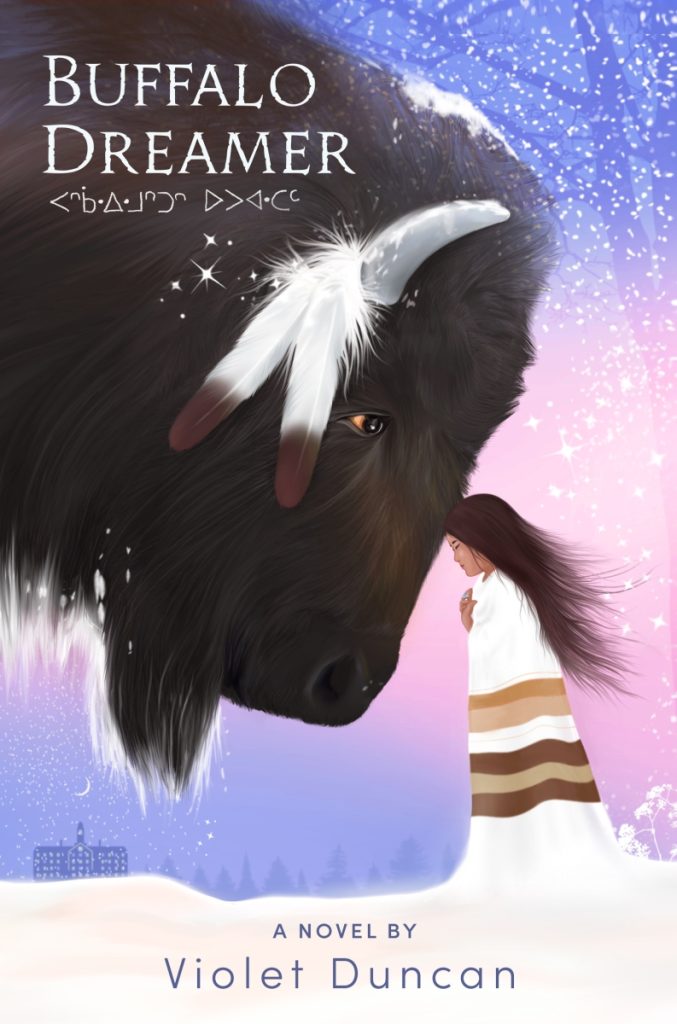Twelve-year-old Summer is on her way, driving, from Arizona to Canada, with her mother and little brother to visit her mother’s people on the Cree Reservation in “Buffalo Dreamer” (Nancy Paulsen 2024) by Violet Duncan. They do this every summer, and her Apache father will join them soon.
on the Cree Reservation in “Buffalo Dreamer” (Nancy Paulsen 2024) by Violet Duncan. They do this every summer, and her Apache father will join them soon.
Before they arrive at her grandparents’ home on the Northern Alberta Cree Rez, Summer falls asleep. The next short chapter sounds like a different voice, an historic voice, another twelve- year-old girl who is running away when a blizzard starts up. She doesn’t want to be punished and thrown in the isolation bin, but someone named Ann has disappeared. The girl knows that Ann never would have left without her. We’ll eventually discover that this is Summer’s dream.
We return to contemporary times. Summer is hugging her cousin Autumn, and all her aunties and her grandparents are crowding around the newly arrived family. Soon, Summer will ride her horse Luna, a gift from her grandfather, Mosom. But first, this warm supportive family will eat a meal together outside.
Together the family witness trucks headed for the old deserted residential school. Summer doesn’t know much, but she knows that Mosom was kidnapped and forced to attend that residential school, starting at the age of five. He had a sister, but she was in the girl’s quarters, and he never saw her again once they’d arrived at the school.
Because Autumn wants to become a detective, the girls eavesdrop outside the kitchen where the aunties are talking. The women are discussing the graves of girls found at the old residential school. Summer and Autumn are aware that graves of children are being discovered at old residential schools throughout Canada and the northern United States, and it’s disturbing to them. The aunties discover the listening girls and instead of punishing them, draw them into the conversation, having decided they’re old enough to know about their Indian history.
Auntie Crystal says, “You know those schools were created to make kids forget about their own culture so that they could be assimilated into the dominant white culture, right?” Summer and Autumn want to talk to Mosom about his experience, but he never talks about it, so they must be sensitive and wait for the right moment.
The girls ride their horses out to where Summer’s mother and brother are picking sweetgrass. Uncle has given Summer a tuft of tobacco to give back to the Earth in exchange. The women and children braid the sweetgrass so they can give these as offerings to the Earth or light them to smudge their homes thereby cleansing them of bad energy.
When Summer has more dreams, her mother hears her speaking a Cree phrase in her sleep, but Summer doesn’t speak Cree. Then she dreams about a Buffalo.
The girls dance at a powwow, and we learn the history of the jingle dance. The community creates a commemorative event at the gravesite of the residential school and we learn why Summer is dreaming about the Buffalo Dreamer. And it is beautiful. Grandfather Mosom calls his former classmates, “fellow survivors” and he tells the girls stories from his life.
I wanted a book like this when I was twelve but nothing like it existed. I love learning the history—and even more, the culture—of Native Peoples in books such as this, which is on the long list of the National Book Award for Young People. It’s a great quick read, at only 100 pages. Put it in the hands of a young reader.
Patricia Hruby Powell is the author of the award-winning books: Lift As You Climb; Josephine; Loving vs Virginia; and Struttin’ With Some Barbecue all signed and for sale at Jane Addams bookstore. Her forthcoming books are about women’s suffrage, Martha Graham, and Ella Fitzgerald. talesforallages.com
Leave a Reply